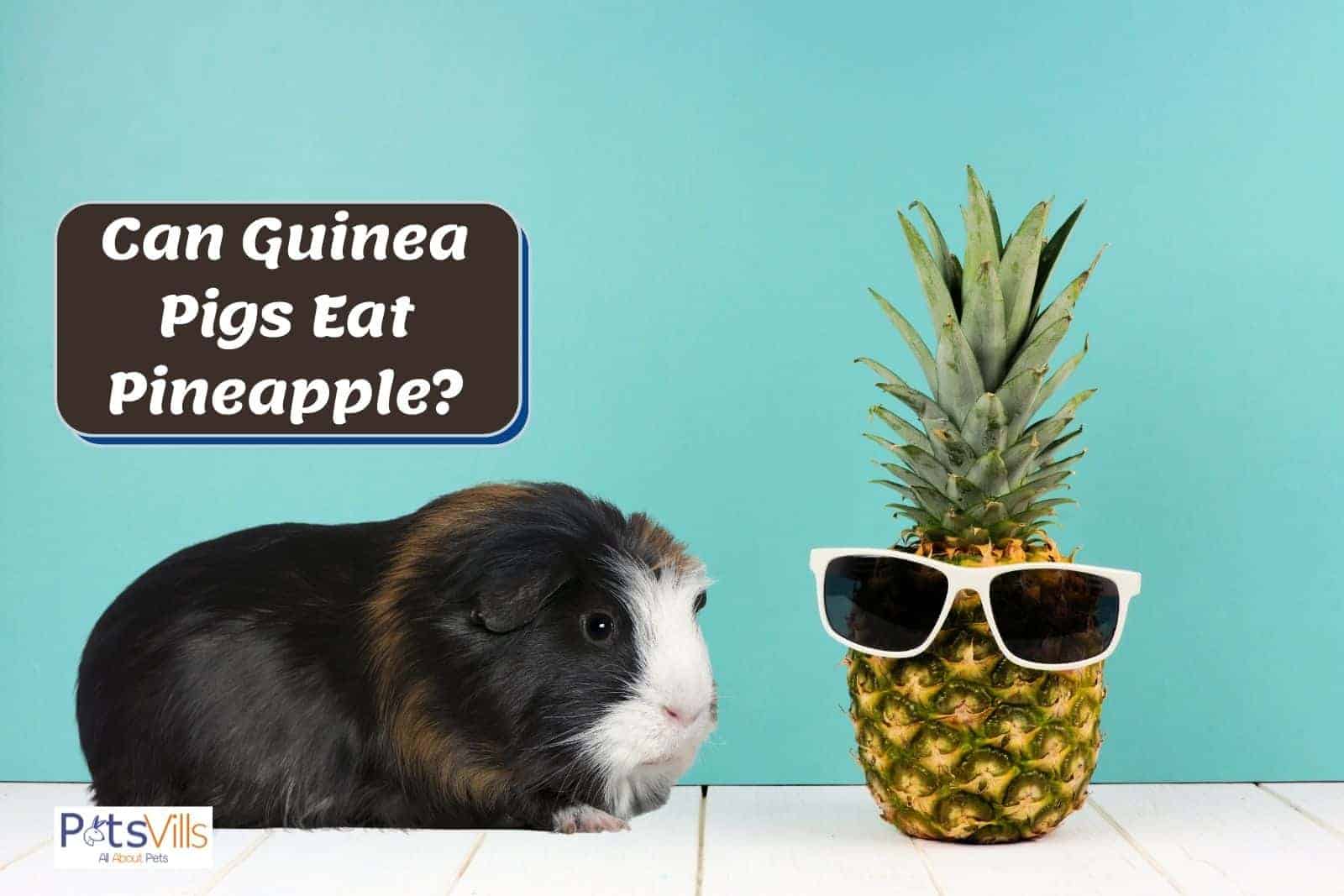Can guinea pigs eat pineapple?
I’ll be taking a deep dive into all things pineapple to give you the definitive answer to this fruity question.
Pineapples are a delicious, relatively healthy snack for us humans.
So, in theory, they should be just as good for your furry friend, right?
Keep reading for all the facts you need to know…
READ MORE: List of Safe Guinea Pig Veggies
Table of Contents
Can Guinea Pigs Eat Pineapple?
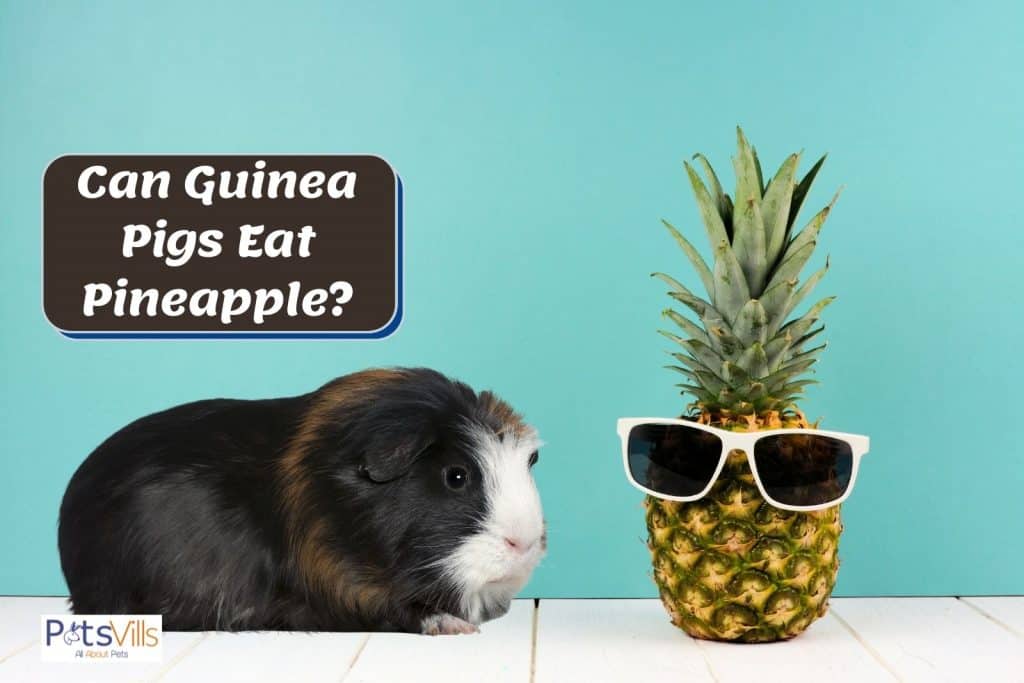
It is perfectly safe to feed guinea pigs pineapple. It’s non-toxic for cavies, so don’t panic if your piggy has managed to eat some accidentally.
Veterinary Dr. Ivana Crnec (DVM) advises that pineapples even contain some nutrients, such as vitamin C, that are beneficial to cavies.
Dr. Crnec does, however, go on to explain that you should only give this tropical snack to guinea pigs in moderation. The sugar, calcium, water, and acid content of pineapple can cause a range of cavy health problems.
More on those later…
To summarise, you can only feed guinea pigs pineapple in small, infrequent amounts to avoid potential health problems.
Can Guinea Pigs Eat Pineapple Leaves?
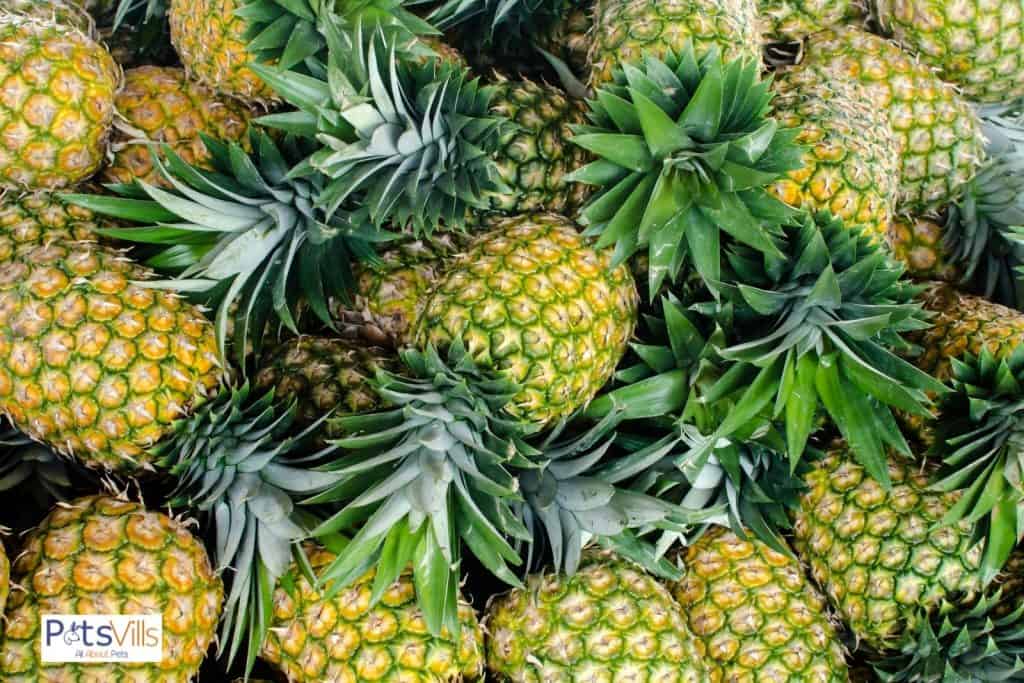
In a word, no. Pineapple leaves contain nothing that would be beneficial to guinea pigs and have a few qualities that make them harmful.
A substance found in the leaves called bromelain can be toxic to guinea pigs who are sensitive to it.
Even guinea pigs who are ok with bromelain are going to struggle to chew and swallow the stiff, waxy leaves.
If a cavy does manage to swallow a chunk of leaf, it still has the potential to cause blockages in the digestive tract.
The final case against giving guinea pigs pineapple leaves is the sharp thorny tip found on each leaf. If it doesn’t cause injury to a cavy’s mouth, it will undoubtedly do some damage internally.
Can Guinea Pigs Eat Pineapple Skin?
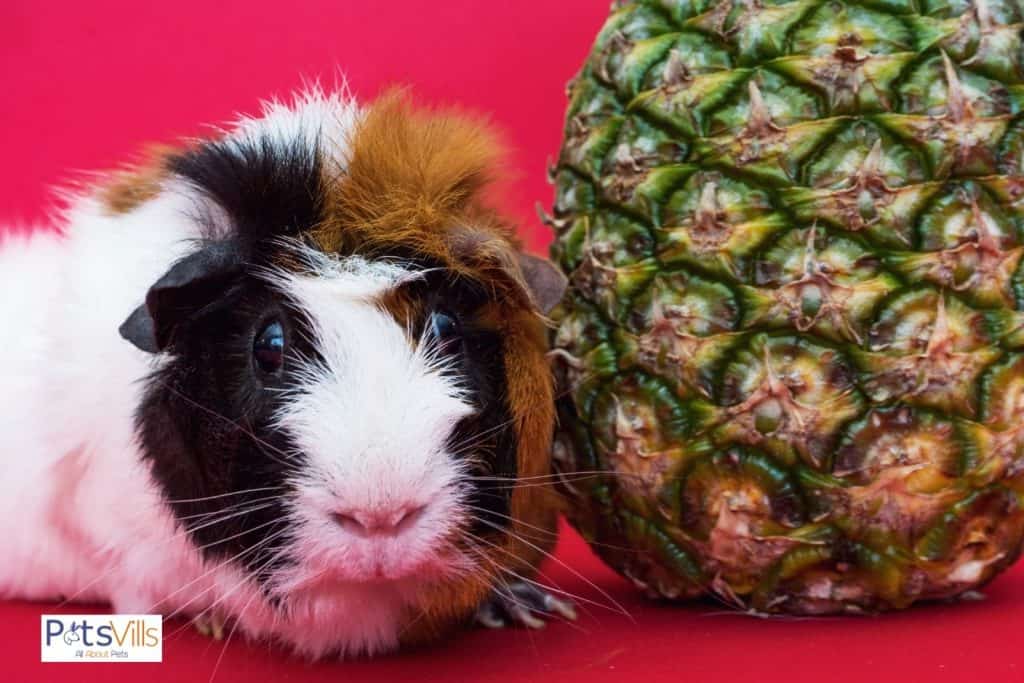
Just like the leaves, it is inadvisable to feed guinea pigs pineapple skin. For one, the skin also contains bromelain.
The skin is tough to chew and has multiple spiky thorns spread across its surface.
It has the potential to harm a guinea pig’s teeth and mouth and cause choking and internal blockages.
For all the reasons listed above, it’s definitely something to avoid giving to your guinea pig.
Can Guinea Pigs Eat Pineapple Cores?
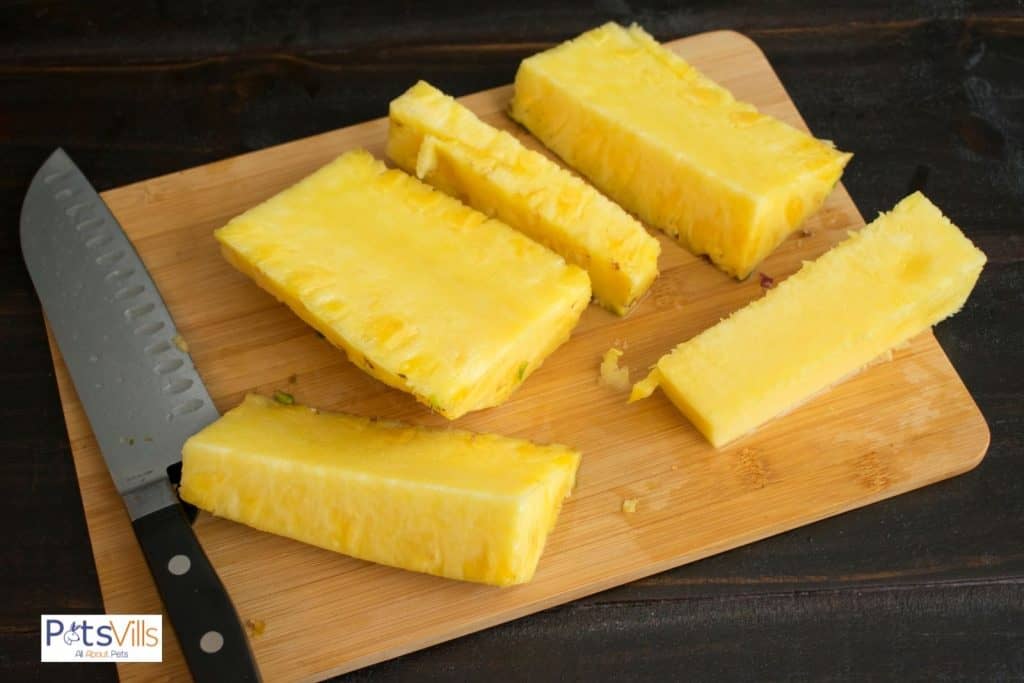
Cores are another part of this tropical fruit your cavy should not be eating. The core contains a higher concentration of bromelain, which some cavies react badly to.
Cores are also super tough, hard to chew, break down, and digest. At best, this will cause indigestion; at worst, it could result in choking or internal blockages.
Humans don’t eat the pineapple core, and neither should your pet guinea pig.
Can Guinea Pigs Eat Frozen Pineapple?
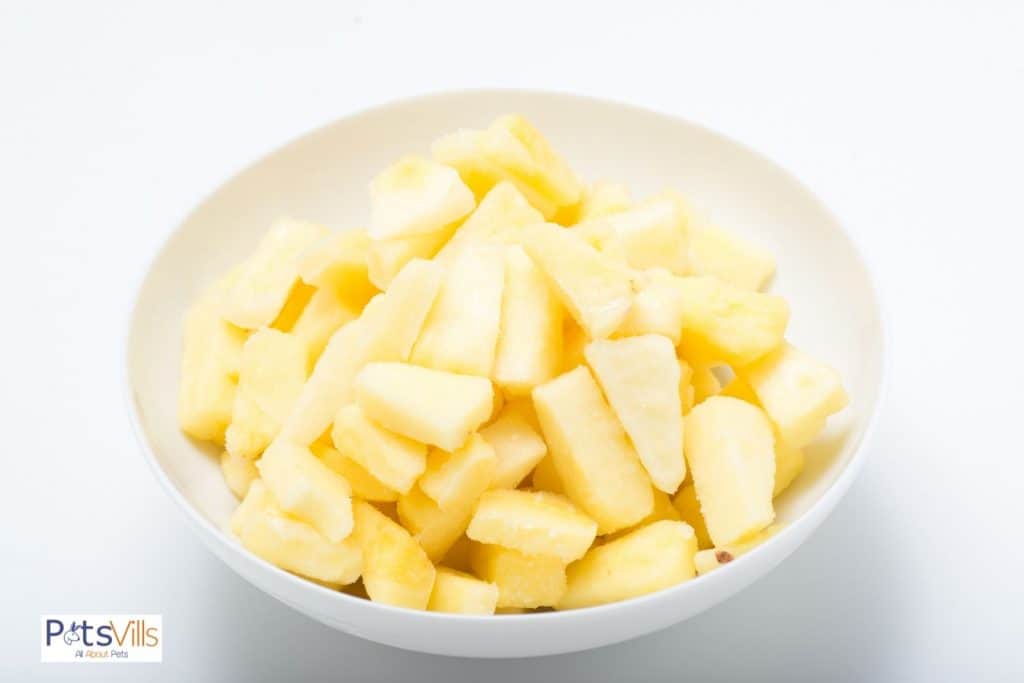
Avoid giving your guinea pig frozen pineapple. While it may seem like you’re giving your cavy his very own popsicle, he’s not going to tackle it the same way you or I would.
Your cavy will try to bite and chew the piece of frozen fruit, placing a lot of stress on his teeth. There is a real risk of cracking or snapping a tooth.
I couldn’t find any hard and fast data specific to pineapples, but freezing can degrade the quality of fresh fruits and veggies. Some manufacturers add chemical compounds to fruit to minimize this effect.
We recommend giving your guinea pig fresh pineapple and leaving the frozen fruit for your next smoothy or cocktail.
If you’re looking for other refreshing snacks to give your cavy, maybe consider researching whether can guinea pigs have watermelon.
If you still want to feed your cavy the frozen variety, be sure to thaw it out well to avoid choking or dental damage.
Can Guinea Pigs Eat Canned Pineapple?
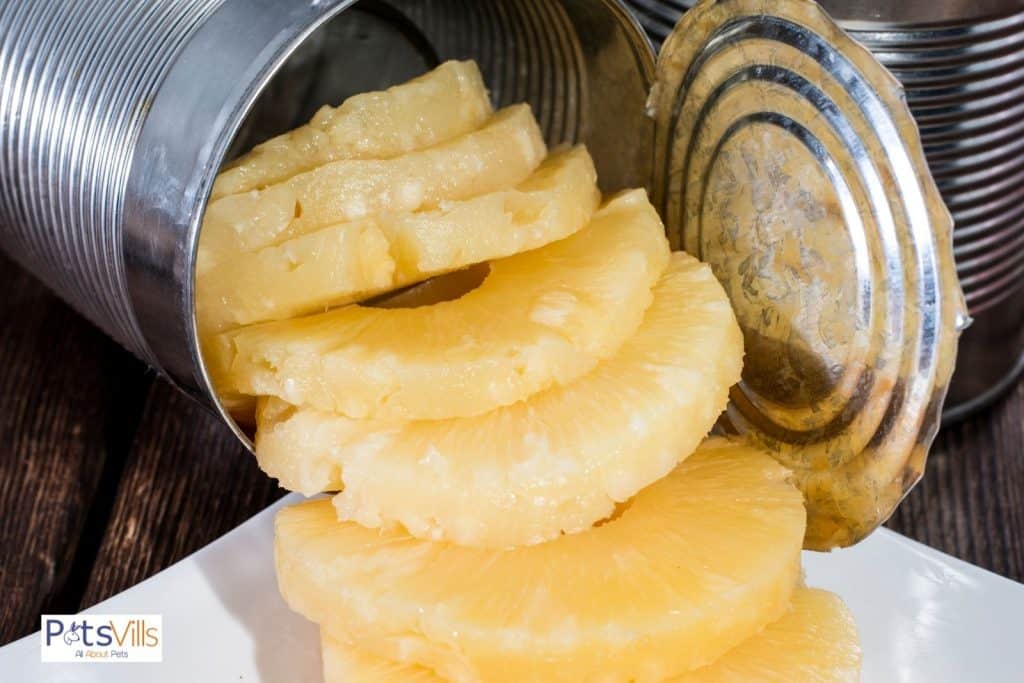
Canned pineapple gets a hard no from us. The sugar added to canned fruit raises the already high sugar content to levels well beyond what a guinea pig can handle.
The same is also true of pineapple juice and dried pineapple. They have extra sugar and potentially other harmful additives too.
I’ll go into more detail on the adverse effects and health problems sugar can cause for guinea pigs later, but you should already have a good idea based on what you know about sugar and humans.
Check out this video:
READ MORE: Can Guinea Pigs Eat Grapes?
Is Pineapple Good For Guinea Pigs?
Nutritional Values Per 100 grams of Pineapple
| Water | 86 g |
| Energy | 50 kcal |
| Protein | 0.54 g |
| Total lipid (fat) | 0.12 g |
| Carbohydrate | 13.1 g |
| Fiber | 1.4 g |
| Sugars | 9.85 g |
| Calcium, Ca | 13 mg |
| Magnesium, Mg | 12 mg |
| Phosphorus, P | 8 mg |
| Potassium, K | 109 mg |
| Vitamin C | 47.8 mg |
| Vitamin B-6 | 0.112 mg |
| Folate | 18 µg |
| Vitamin A | 3 µg |
| Carotene, beta | 35 µg |
| Vitamin E | 0.02 mg |
| Vitamin D (D2 + D3) | 0 µg |
| Vitamin K | 0.7 µg |
What Do These Nutrients Do?
- Fiber – Helps to prevent overeating, prevents constipation, and helps to regulate the absorption of other nutrients.
- Calcium – Contributes to the strength and health of bones and teeth.
- Vitamin C – Prevents scurvy, aids wound healing processes, and plays a role in iron absorption.
- Vitamin B-6 – Regulates the metabolism of proteins, fats, and carbohydrates.
- Folate – Used in cell division and the production of DNA and other genetic material.
- Vitamin A – Helps improve night vision, heal the cells lining the gut and respiratory system, and develop bones and teeth.
- Vitamin D – Needed to absorb calcium.
- Vitamin K – Aids in the blood clotting process.
How Pineapple Could Benefit Guinea Pigs
Vitamin C Prevents Scurvy
Just like us people, guinea pigs are not able to produce their own vitamin C. As a result, they need to get their daily vitamin C requirement from their food.
A cavy’s reliance on food as a source of vitamin C leaves them prone to becoming deficient in this essential vitamin and vulnerable to scurvy.
Scurvy affects the body’s ability to manufacture collagen, a vital ingredient in making bone and tissue cells. The condition also causes problems with blood clotting and can affect the skin and joints.
Sadly, vitamin C deficiency is a common problem in guinea pigs.
The good news is that it can be rectified quickly by an improved guinea pig diet and vitamin C supplementation.
Vitamin A & Beta Carotene Promote Eye Health
Beta carotene isn’t an essential nutrient in its own right, but your cavy can convert it to vitamin A.
Not only that, the body will only convert as much as it requires, avoiding vitamin A toxicity.
As a bonus, beta carotene is also an antioxidant, so it protects the body from free radicals. This has been linked to lower risks of developing heart disease and cancer.
As I already mentioned above, vitamin A is responsible for the health of the immune system, eyes, skin, and cells that line vital organs (mucus membranes).
Fiber Promotes a Healthy Digestive System
Fiber serves a few purposes in a guinea pig’s diet. Primarily, it plays a vital role in the health of the digestive system.
Fiber contributes to the balance of bacterial flora in the gut and also helps to sweep any particles and debris from the digestive tract and intestines.
Secondly, chewing foods that are high in fiber helps to grind a cavy’s teeth down and maintain their correct length.
The main source of a guinea pig’s fiber should be hay.
Hay is the staple of their diet, and they should always have it available. Grass hay such as timothy hay is the most frequently recommended variety.
How Pineapple Could Harm Guinea Pigs
Obesity & Diabetes
Eating food that is high in sugar can contribute to obesity, diabetes, and obesity-related health problems.
Most fruit is high in sugar, which should come as no surprise based on how sweet it tastes. Sugar accounts for a little under 10% of a pineapple’s makeup, meaning it’s relatively high in the sweet stuff.
A small amount of fruit isn’t going to hurt your cavy, but regularly consuming food with high sugar content is likely to cause obesity.
Diabetes is not very common in guinea pigs, which is perhaps why it’s not widely known that cavies can get type 1 and type 2 diabetes.
Interestingly, unlike diabetes in humans, it can be reversed in guinea pigs through a corrective diet and medication.
Calcium, Oxalates & Phosphorus
We know that some calcium is good for your cavy. It helps to build strong and healthy bones and teeth. But, when combined with other nutrients, it can cause some painful health problems.
Oxalates (oxalic acids) bind to calcium, forming bladder stones. These can be painful to pass and can also cause blockages.
Pineapple is a low oxalate food, so the risks are much lower than with other fruit such as blueberries.
Canned pineapple has a moderate oxalate content, another reason to leave it off the menu.
The other pairing to look out for is calcium and phosphorus. Again, phosphorus binds to calcium, making it difficult/impossible to absorb. It can also lead to the formation of stones.
As a general rule of thumb, there should be more calcium than phosphorus per gram to avoid problems. Fortunately, this is the case with pineapple.
High in Acid
Much like oranges and grapefruits, pineapple is high in acid. Regularly eating fruit that is high in acid can give guinea pigs mouth sores.
The acid literally eats away at their skin, causing irritation and eventually sores. In moderation, this won’t be a problem.
Diarrhea
Guinea pigs have a sensitive digestive system, and there are a few things that can result in them having an upset stomach or diarrhea.
Too much water can cause a cavy to experience the above issues. Pineapples are 86% water, so overeating this fruit could trigger a response.
The is true of large quantities of sugar. Too much can trigger stomach upsets and soft stool.
Choking
We covered this already, but it’s worth mentioning again. Pineapples are prickly customers.
The leaves and skin are spiky, tough, yucky parts of the fruit that you should never give to your cavy.
The pineapple core is very stiff and fibrous, too, making it hard to chew and swallow. All of these parts could be a choking hazard for guinea pigs, and you should discard them.
What Do Guinea Pigs Eat?
When researching any potential new snacks, sweet treats, or foods for your guinea pig, it helps to know what makes the foundations of a healthy guinea pig diet.
Guinea pigs are herbivores. That means they only eat plant-based foods. They need to have food constantly moving through their digestive system to avoid potential health problems.
Their diet should be low in carbs and fat, and high in fiber. As I touched on earlier, all of their vitamin C needs to come from dietary sources as they can’t produce their own.
Hay
80% – A whopping 80% of your guinea pig’s diet should consist of hay. Grass hays like timothy and orchard grass are commonly available in pet stores and are the preferred type for adult cavies.
Alfalfa hays, which are higher in calcium and protein, should only be fed to guinea pigs under six months of age or lactating females.
Fresh hay should be available to your cavy at all times.
Guinea Pig Pellets
10% – Guinea pig pellets make up another 10% of the generic balanced diet for cavies. These tend to be hay-based and are sometimes fortified with other ingredients or nutrients such as vitamin C.
A standard daily portion of pellet feed is usually 1 to 2 tablespoons. This will vary based on the brand of guinea pig food and any veterinary advice you have been given specifically regarding your pet.
Leafy Greens
10% – The rest of your guinea pig’s daily diet should consist of a nice, healthy salad of leafy green veggies.
Not all greens are created the same, and some are better for your cavy than others. In fact, some can even be just as bad for guinea pigs as fruit.
It’s essential to educate yourself on the best leafy greens for guinea pigs. Cilantro, swiss chard, and romaine lettuce are among some of the best options based on calcium and oxalate content.
Vitamin C
You’ve had me go on at you about the importance of vitamin C, so it’s only right it gets its own section here.
It’s best if your cavy can get all of its vitamin C from food. There are supplements, but the water additives tend to degrade quickly, and the vitamin C added to pellets breaks down over time.
Bell peppers are an excellent source of vitamin C. They have more of this essential vitamin than oranges! Peppers also contain nowhere near as much sugar as oranges, so it’s a win-win.
Treats & Everything Else
What? Fruit wasn’t even on the list? Exactly, so now you’ll know that you shouldn’t be feeding your cavy any fruit frequently or in large quantities. At best, they don’t need them; at worst, fruit can be harmful to them.
Fruit is an occasional treat; we’re talking a few times per week at most. Want to know how much pineapple a vet recommends feeding your cavy?
Feeding recommendations up next…
How To Feed Your Guinea Pig Pineapple
How Much Pineapple to Give Guinea Pigs
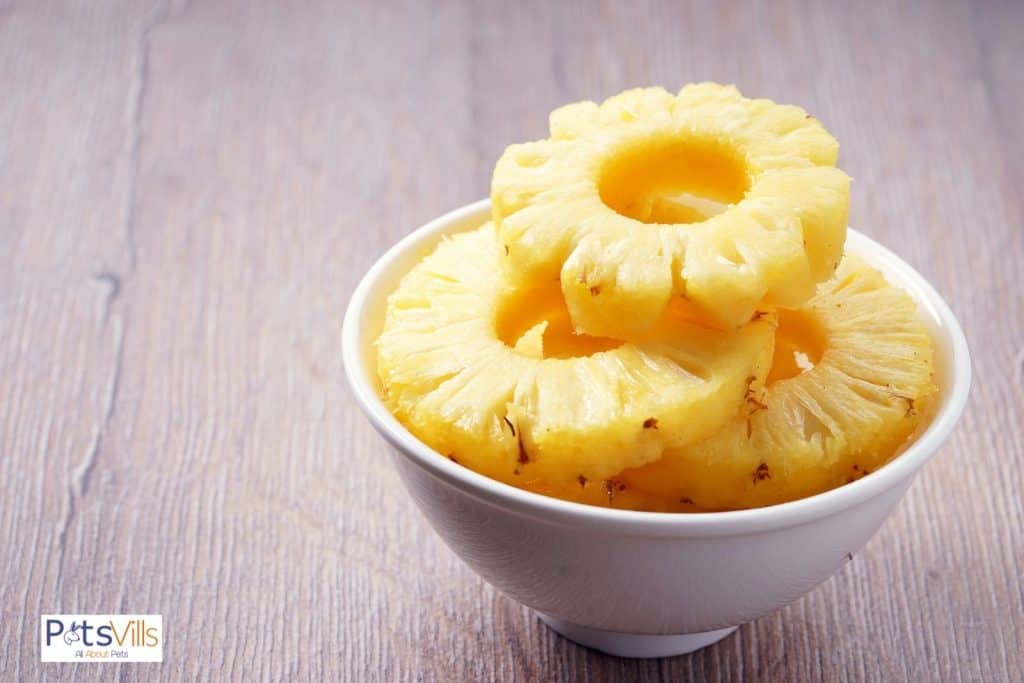
Veterinary Dr. Ivana Crnec recommends that it’s ok to feed your guinea pig a portion of pineapple once a week and certainly no more than two times a week.
A guinea pig-sized portion of pineapple is one cubic inch. You can chop this piece of pineapple into more manageable chunks if necessary.
Remember, it’s a treat, not a meal. Your objective is to give your piggy something different, interesting, tasty, and fun. Not to fill them up.
How To Prepare Pineapple For Guinea Pigs
- Buy a fresh, ripe pineapple you can find from your local market or produce store. Take it home and give it a rinse under fresh water.
- Using a sharp knife, chop off the top and bottom of the pineapple. Discard the leaves as you can’t give them to your cavy, and I doubt you want to eat them!
- Cut off the pineapple skin and take care to remove any eyes from the flesh. Think along the lines of eyes in a potato, and you’ll know what I mean.
- Slice, dice, and chop the fruit however you want, making sure to cut the pineapple core away from the rest of the fruit flesh.
- Prepare a one-inch cube of pineapple for your cavy and chop it into smaller chunks if they’re more manageable for your pet.
- Serve and monitor. If this is the first time you’ve given pineapple to your guinea pig, keep an eye on them to see how they react. Some guinea pigs are allergic to the bromelain enzymes it contains.
- Remove any uneaten pineapple from your guinea pig’s cage before the sweet treat turns bad.
Find out if the guinea pigs will eat the pineapple in this video:
Guinea Pig – Pineapple FAQs
Can you feed a guinea pig pineapple?
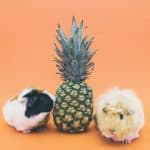
You can feed a guinea pig pineapple in moderation. It’s not toxic to them, but the high sugar and acid content means that overeating has the potential to cause issues like obesity, mouth sores, and diabetes.
How much pineapple can guinea pigs eat?
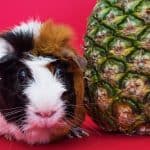
Veterinary advice is that it’s safe to feed a guinea pig a one-inch cube of fresh pineapple one to two times per week. Anything more than this means that the potential health risks outweigh the potential health benefits.
Do guinea pigs eat pineapple skin and leaves?
You should not feed a guinea pig pineapple skin or leaves. Both have sharp thorns, are extremely tough to chew, and pose a choking hazard. They also contain bromelain, a substance that some guinea pigs are allergic to.
Can guinea pigs drink pineapple juice?
No, guinea pigs should not drink pineapple juice as it has a higher sugar content than raw fruit. This extra sugar is even more likely to cause digestive problems and other sugar-related problems such as diabetes.
In Conclusion: Can Guniea Pigs Have Pineapple?
Can guinea pigs eat pineapple? That’s the question I set out to explore, explain, and answer in this article.
If you read from top to bottom, this section serves as a quick recap. If you skimmed through, this is all of the essential facts condensed into a few paragraphs.
Guinea pigs can eat pineapple, but only in moderation. That means a portion of a one-inch cube, given no more than two times a week.
This fruit’s vitamin C content could help cavies reach their daily requirement of this essential vitamin, but there are also health risks.
The high amount of sugar and acid found in pineapples can cause a range of health problems, including obesity, diarrhea, diabetes, and mouth sores.
The important thing is that you’ve taken the time to research this topic and can now feed your guinea pig pineapple safely.
Thanks for being a responsible guinea pig owner, and thanks for reading!
References
- Hughes, E 2021, Can Guinea Pigs Eat Pineapple? Vet Approved Feeding Guide, Feeding My pet, viewed 2 July 2021, <https://www.feedingmypet.com/can-guinea-pigs-eat-pineapple/>.
- Bresolin, I et al. 2013, Isolation and Purification of Bromelain from Waste Peel of Pineapple for Therapeutic Application, Brazilian Archives Of Biology And Technology, viewed 2 July 2021, <https://core.ac.uk/download/pdf/296617038.pdf>.
- Schafer, W 2018, The Science of Freezing Foods, University of Minnesota, viewed 2 July 2021, <https://extension.umn.edu/preserving-and-preparing/science-freezing-foods>.
- Pineapple, Raw 2020, U.S. Department of Agriculture, viewed 2 July 2021, <https://fdc.nal.usda.gov/fdc-app.html#/food-details/1102688/nutrients>.
- Nutrition Module 2: Nutrients and their Sources n.d., The Open University, viewed 2 July 2021, <https://www.open.edu/openlearncreate/mod/oucontent/view.php?id=315&printable=1>.
- Vitamin C Deficiency in Guinea Pigs 2010, Pet MD, viewed 2 July 2021, <https://www.petmd.com/exotic/conditions/cardiovascular/c_ex_gp_vitamin_c_deficiency>.
- Newman, T 2017, What is Beta Carotene? What Are The Benefits?, Medical News Today, viewed 2 July 2021, <https://www.medicalnewstoday.com/articles/252758>.
- Hébert, J (DVM) n.d., Nutrition For Guinea Pig, Centre Vétérinaire Laval, viewed 2 July 2021, <https://cvlaval.com/en/exotic-services/fact-sheet/nutrition-guinea-pig.html>.
- Diabetes In Guinea Pigs n.d., Net Vet, viewed 2 July 2021, <https://netvet.co.uk/small-animals/guinea-pigs/diabetes/>.
- Labelle, T 2019, What Can Guinea Pigs Eat?, Exotic Direct, viewed 2 July 2021, <https://www.exoticdirect.co.uk/news/what-can-guinea-pigs-eat-food-unsafe-food-and-dietary-requirements>.
- O’Connor, H (RD) 2015, The Oxalate Content of Food, Dr. Cheryl Kasdorf, viewed 2 July 2021, <https://drcherylkasdorf.com/wp-content/uploads/2015/02/OxalateContent092003.pdf>.
- Caring For Your Pet Guinea Pig 2016, NC State Veterinary Hospital, viewed 2 July 2021, <https://cvm.ncsu.edu/wp-content/uploads/2016/12/Caring-for-your-Guinea-Pig.pdf>.
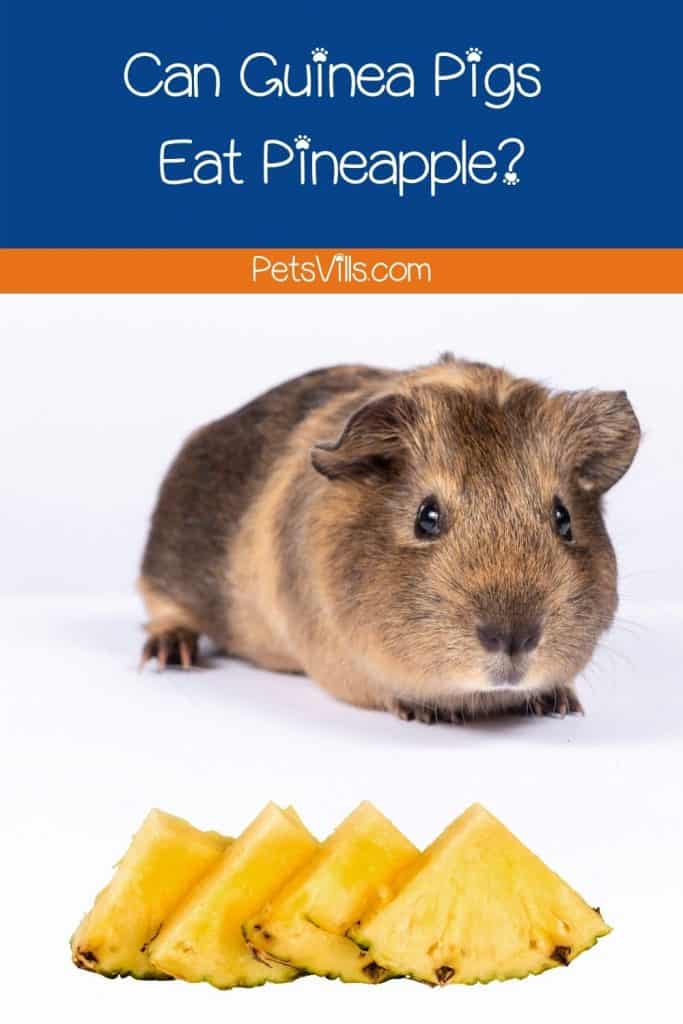
Can Guinea Pigs Eat Pineapple? Share your thoughts in the comments below!
Barry Stingmore is a British content writer living in Fuerteventura, Spain. An animal lover at heart, he shares his home with a dog and four rescue cats and has a passion for writing about animals big and small.
Barry loves finding answers to your animal-related questions, the more research involved the better! You can rely on him to find the facts.
Find him on FACEBOOK, TWITTER AND Linkedin
Read his latest ARTICLES.
Find more about him HERE.

